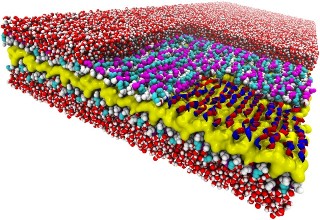A new 'design rule' that faciliates the synthesis of synthetic protein analogues, called peptide nanosheets, has been discovered. The peptide nanosheets display a flatness that is not observed in nature. It is hoped that exploitation of this new rule will lead to the synthesis of novel biomimetic structures.
 Snakes on a plane: This atomic-resolution simulation of a two-dimensional peptoid nanosheet reveals a snake-like structure never seen before. The nanosheet’s layers include a water-repelling core (yellow), peptoid backbones (white), and charged sidechains (magenta and cyan). The right corner of the top layer of the nanosheet has been 'removed' to show how the backbone’s alternating rotational states give the backbones a snake-like appearance (red and blue ribbons). Surrounding water molecules are red and white. (Credit: Ranjan Mannige, Berkeley Lab)
Snakes on a plane: This atomic-resolution simulation of a two-dimensional peptoid nanosheet reveals a snake-like structure never seen before. The nanosheet’s layers include a water-repelling core (yellow), peptoid backbones (white), and charged sidechains (magenta and cyan). The right corner of the top layer of the nanosheet has been 'removed' to show how the backbone’s alternating rotational states give the backbones a snake-like appearance (red and blue ribbons). Surrounding water molecules are red and white. (Credit: Ranjan Mannige, Berkeley Lab)
A recent aim of scientific research has been the production of nanostructures that mimic the complexity and function of biological proteins but are made of synthetic and durable materials. Such nanostructures can be modified to be used as durable catalysts, highly-sensitive chemical detectors and more.
A high level of precision is needed to customize the precursors before they can be sued to construct the nanostructures. The Berkeley Lab researchers are now one step closer to achieving this reality.
The researchers discovered a new deign rule that allowed them to produce peptoid nanosheets. Peptoid nanosheers contains peptoids, the synthetic equivalent of peptides, and are characterized by a flat, two molecule-thick structure. This new ‘molecular paper’ serves as a perfect protein-imitator to be used in molecular design.
With the aid of the new 'design rule' it was possible to regulate the way polymers link together to create the backbone, which runs along the length of the peptoid nanosheets. It was observed that these polymers join together in a unique counter-rotating pattern, which so far has never been observed in nature.
This counter-rotating pattern ensures that the backbones remains untwisted and linear making the peptoid nanosheets flatter and larger when compared to natural structures.
According to the researchers this unique design rule makes it possible to join peptoid assemblies like crystalline solids, nanotubes and intricate nanosheet structures.
This breakthrough was made by integrating computer simulations with imaging and X-ray scattering techniques to establish the first atomic-resolution structure of the peptoid nanosheets.
This research suggests new ways to design biomimetic structures. We can begin thinking about using design principles other than those nature offers.
Steve Whitelam - Berkeley Lab
Whitelam headed the study with Ranjan Mannige, the co-corresponding author and a postdoctoral researcher at the Molecular Foundry; and Ron Zuckermann, who heads the Molecular Foundry’s Biological Nanostructures Facility. Whitelam is also a staff scientist at the Molecular Foundry’s Theory Facility, which is a DOE Office of Science user facility based at Berkeley Lab.
Five years ago, Zuckermann’s research team made the breakthrough discovery on peptoid nanosheets. They observed that, when using the right conditions, these nanosheets are capable of self-assembling into 2D assemblies which in turn can grow countless of microns across.
New insights about the peptoid nanosheets were obtained from an analysis which used molecular dynamics simulations alongside X-ray scattering and microscopy data. The molecular make up of peptoid nanosheets is different throughout their structure. Only peptoids of a specific minimum length can be used to form the nanosheets. These sheets have water pockets and demonstrate porosity towards ions and water.
Typically proteins existing in nature are made up of alpha helices and beta sheets. These are the basic building blocks of proteins and each has a backbone along its structure. The same rule joins all the polymers that combine to become these backbones. A twist exists along the backbone because neighboring peptides incrementally rotate in the same direction.
Newly Discovered ‘Design Rule’ Brings Nature-Inspired Nanostructures One Step Closer
The researchers observed that this typical rule did not apply to the peptoid nanosheets. Adjacent monomer units along the backbones of the peptoid nanosheets rotate in opposite directions. As these are counter-rotations, the rotations cancel one another out, resulting in an untwisted, linear backbone.
As a result the backbones can be tiled in two dimensions, and larger sheets can be created that possess a flatness that has not been observed in nature.
It was a big surprise to find the design rule that makes peptoid nanosheets possible has eluded the field of biology until now. This rule could perhaps be used to build many more unrealized structures.
Ranjan Mannige - Berkley Lab
We also expect there are other design principles waiting to be discovered, which could lead to even more biomimetic nanostructures.
Ron Zuckermann - Berkley Lab
Thomas Haxton, Alessia Battigelli, Ellen Robertson and Caroline Proulx, all from the Molecular Foundry, also contributed to the research.
The study was performed at Berkeley Lab’s Molecular Foundry. The Defense Threat Reduction Agency supported the study. The Natural Sciences and Engineering Research Council of Canada provided additional funding. A User Project at the Molecular Foundry headed by Glenn Butterfoss of New York University carried out part of this work.